Storytelling connects people to Michigan’s natural, cultural resources
By TOBI VOIGT
Michigan Department of Natural Resources
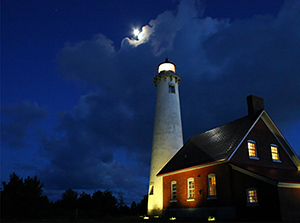
When I mention that I work for the Department of Natural Resources, I often get puzzled looks and comments along the lines of, “You don’t look like a park ranger” or “I didn’t know you are a hunter.”
For some, the DNR is all about hunting and fishing. For others, it’s about wildlife habitat conservation or forest management. Some people know that the DNR conserves, protects and manages not only our state's natural resources but also many of its cultural resources.
As the community engagement director for the DNR’s Michigan History Center, which includes the Archives of Michigan and 12 museums and historic sites, I know the DNR as an agency that collects and shares the stories of our state’s people, places and events.
Whether told around the campfire or in a family kitchen, these stories are valuable cultural assets. Taken together, they provide a fuller picture of the rich and diverse lives – then and now – of our state’s greatest resources: its people.
The DNR has always been invested in communities across the state, whether it is gathering public input on projects, making the most of hunter, angler and trail-rider license revenue, meeting needs at customer service centers or providing robust educational programs at parks, forests, museums and historic sites.
Over the last few years, several projects have emerged that center around storytelling, with the goal of collecting and sharing the unique perspectives and stories of Michiganders.
Sharing state parks stories
|
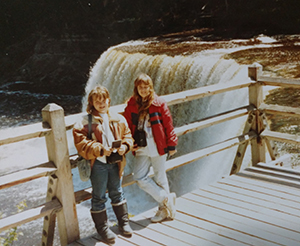
In celebration of the 2019 Michigan state parks centennial, the DNR launched an interactive memory map to capture the special stories and snapshots that people have made at state parks over the years.
“We wanted to capture the camping trips, family traditions, fish tales, Scouting excursions, day hikes and more that people have made over the years,” said Maia Turek, resource development specialist for the DNR Parks and Recreation Division.
By tapping into the power of ArcGIS technology, hundreds of visitors and staff were able to bring their state parks memories to life by sharing a story and photo and marking the location on a map. In many ways, the project served much like a virtual guest book.
To date, more than 600 people have shared memories like these:
"My Gram and Papa loved to travel. Often, they took my sister, Fawn and I along on their Michigan adventures. We visited a lot of state parks like Silver Lake, Palms Book, Tahquamenon Falls and more! Here we are at the falls...circa 1985." (Tahquamenon Falls State Park, Chippewa County)
|
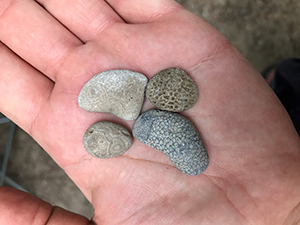
I was lucky to have been part of the Keeper program at the lighthouse twice in the past. What a special experience – living in the lighthouse and giving tours to visitors. Lighthouses are America's castles and Tawas Point Light is certainly a gem! We are so lucky to [have] this historic site to share the history of Michigan to all! (Tawas Point State Park, Iosco County)
“This is a picture of my mom and dad in 1948 on the beach at Grand Haven [State Park]. It was their first (blind) date, arranged by a mutual friend. They later married and spent 61 years together. They always remembered and referred to the Grand Haven date in their stories for years; it was a special place for them. (Grand Haven State Park, Ottawa County)
“One of my favorite state park memories is fossil hunting on the beach at the state park. I spent hours in the cool bay, sifting through the rocky shoreline to find some pretty rocks. I did find a couple of small Petoskey stones, but I love all the fossils! And I left behind all but these four for other treasure hunters!” (Petoskey State Park, Emmet County)
|
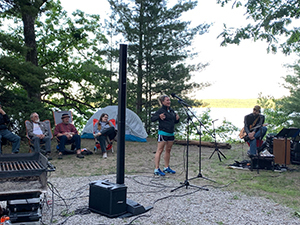
As part of the state parks centennial, the DNR also hosted the Campfire Storytelling Project, through which seasoned storytellers shared their personal park memories, and attendees were invited to share their anecdotes, at events held around a campfire in various state parks.
Both centennial storytelling projects were symbolic of what lies at the heart of Michigan's state parks system: the millions of visitors who have come to our parks over the last 100 years.
Telling Michigan’s stories
|
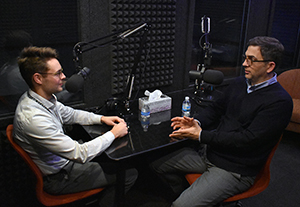
The Michigan History Center kicked off its inaugural story collection project in 2019, when it partnered with StoryCorps, the national nonprofit with a mission to preserve and share humanity’s stories in order to build connections between people and create a more just and compassionate world.
“The Center has always done traditional oral history interviews, where a facilitator asks a series of scripted questions about a particular event or to collect a person’s life story,” said state archivist Mark Harvey, who initiated the StoryCorps partnership. “We were attracted to StoryCorps because of its dialogue-based model. It opens up the experience and allows people to explore topics and conversations of their choosing.”
StoryCorps recordings are simply recorded conversations between two people who know each other very well, typically family, friends or even colleagues. What the pairs discuss is up to them, and no two recordings are alike.
The Michigan History Center contracted with StoryCorps to record 60 conversations within the Greater Lansing area in 2019 and 2020. Twenty-six have been completed to date.
|

“I only knew a little about StoryCorps, having heard snippets on NPR,” said Melik Brown, Lansing entrepreneur and early participant. “I asked a good friend and business colleague to do it, and we had a lively conversation. I have often wondered what would be said of me and my place in history. Now I know at least part of my story will be told by me.”
The stories, like all StoryCorps recordings, will be archived at the Library of Congress and also with the Archives of Michigan. Later this year, the audio recordings and full transcripts will be posted on Michiganology.org.
Preserving and learning from stories
With a population of nearly 10 million people, Michigan has a seemingly endless supply of stories. One may wonder, “What will the DNR DO with the stories it collects?”
A primary goal is to make them available to the public, which includes present and future researchers and historians. The centennial memory map uses engaging GIS technology to plot stories on a map. Once properly formatted and transcribed, the campfire storytelling and StoryCorps projects will be available on the DNR website.
“One of the biggest challenges historians and researchers face is a lack of source material,” said Harvey. “Past archivists made choices about what to save, and priority was often given to legal documents and the collections of prominent leaders and business owners. Records of the daily lives of individuals are often missing in collections. These projects are helping to correct that.”
But these stories won’t be important just to future historians – they are making a difference in how the DNR interprets and shares information now. The Michigan History Center staff is learning from the stories and incorporating them into exhibits and programs.
It’s similar with the DNR Parks and Recreation Division.
“Knowing how people enjoy and use our parks – and what features are most important to them – will help us plan programs and potential park improvements,” said Turek.
Do you have a story you’d like to tell? We’d love to hear from you. To share your park story on the map, visit the Michigan State Parks Centennial website at Michigan.gov/StateParks100.
If you’d like to learn more or inquire about an interview with the Michigan History Center’s StoryCorps project, send us an email at MHCInfo@Michigan.gov.
|
Check out previous Showcasing the DNR stories in our archive at Michigan.gov/DNRStories. To subscribe to upcoming Showcasing articles, sign up for free email delivery at Michigan.gov/DNR.
/Note to editors: Contact: Casey Warner, 517-284-6079. Accompanying photos and a text-only version of this story are available below for download. Caption information follows. Credit Michigan Department of Natural Resources, unless otherwise noted.
Text-only version of this story.
Booth 1, Booth 2 and Booth 3: Archives of Michigan staff members Mark Harvey (dark shirt) and Jason Schultz test the equipment in the sound booth used during StoryCorps recordings.
Campfire: A camper shares a personal story at one of 2019 Campfire Storytelling Project events at state parks across the state.
Grand Haven: A couple – who later married and spent 61 years together – on the beach at Grand Haven State Park in 1948 for their first date. Their story is part of the online memory map that collected state parks stories as part of the parks’ centennial celebration.
Petoskey: One contributor to the state parks memory map recalled hunting for fossils on the beach at Petoskey State Park – leaving behind all but these four for other treasure hunters.
StoryCorps: Paul Schmidt and Melik Brown (right) pose for a photograph after their StoryCorps recording. This image will accompany their recording in the Archives of Michigan and Library of Congress. Photo courtesy of Archives of Michigan.
Tahquamenon: A Tahquamenon Falls State Park visitor, pictured here with her sister at the park circa 1985, was one of more than 600 people who shared a story as part of the state parks centennial memory map.
Tawas: This photo submitted for the state parks memory map accompanied the story of a former volunteer lighthouse keeper at Tawas Point State Park, who lived in the lighthouse and gave tours to visitors as part of the program./
|